To what extent will AfCFTA ratification influence carbon emissions?
Evans Opoku-Mensah
(作者:电子科技大学西非研究中心团队,执笔人:Evans Opoku-Mensah(电子科技大学西非研究中心助理)【西非漫谈】2022年第四期,总第五十三期。译者:杜莹、赵韵涵;整理:孟雅琪、张海琳;供稿:赵蜀蓉)

--本文原刊载于环球网(Huanqiu.com)“西非漫谈”栏目
链接:https://opinion.huanqiu.com/article/4703ppvhdmV
1.What is AfCFTA?
"We need to talk about Africa and the AfCFTA., Our Marshall Plan, is the AfCFTA" (Ms. Vera Songwe, 2020). The African Continental free trade Area (hereafter referred to as AfCFTA) is currently regarded as the largest free trade globally as it has connected over 1.2 billion Africans. The AfCFTA agreement was first signed in Kigali, Rwanda, on March 21, 2018, and its operational capacity began on July 7, 2019, in Niamey, Niger, during the African Union's 12th Extraordinary Session. The AfCFTA is instituted by five (5) operational instruments: the Rules of Origin, the online negotiating platform, the monitoring and eradication of non-tariff barriers, a digital payments system, and the African Trade Observatory are the instruments in question. AfCFTA is spearheaded by a framework of the Assembly, the Council of Ministers, the Committee of Senior Trade Officials, and the Secretariat.
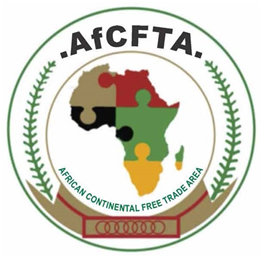
2.Significance of the AfCFTA Agreement Ratification
The agreement primarily seeks to provide a single platform for the transaction of goods and services while reinforcing Africa's economic integration. The AfCFTA Secretariat is dedicated to using the trade industry as a catalyst to help Africa recuperate from the COVID-19 catastrophe. Seeking to eliminate approximately 90% of tariffs and create a single market with free movement of goods and services, Africa's revenue is projected to increase by $450 billion by 2035 due to the commencement of the AfCFTA treaty. Cutting red tape and simplifying customs procedures, the AfCFTA is envisaged to raise Africa's revenue levels and reduce poverty by raising productivity and boosting investment. Thus, the implementation of the AfCFTA would increase the GDP, trade, and welfare of member states.
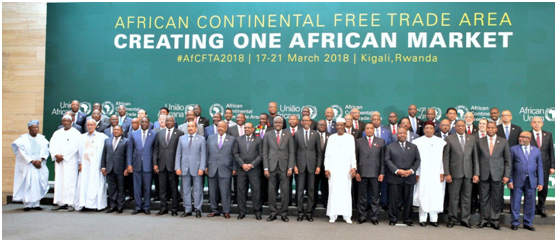
While the agreement is projected to increase trade, discussions regarding the trade treaty's spillover on the environment are scarce. As most African countries depend on imported products that emit excessive carbon emissions, openness in Africa's trade may be a gateway for overflooding emitted products (pollution haven hypothesis). Understanding the potential environmental consequences of the AfCFTA agreement is an important step towards the global sustainable development goals and a step to inform AfCFTA policymakers on the potential environmental consequences that lie ahead with this trade agreement being promulgated.
3.What is the current emissions level of African Countries?
Currently, African countries account for over 4% of the World's total carbon emissions. Africa is the World's only surviving continent with a rapidly rising population and the World's fastest urbanizing region. While 4% may be seen as insignificant, It should be emphasized that coupled with the rapid population trend of the continent and rapid urbanization, most of these countries are vulnerable, and any attempt to increase trade without appropriate mitigation measures could make Africa one of the biggest emitters of carbon emissions and increase global emissions. Figure 2 shows the trend of CO2 per capita for some selected AfCFTA countries. Data is gathered from https://databank.worldbank.org/. Carbon emission per capita is measured in metric tons per capita. The figure shows an overall upward trend, with 2014 having the largest value.
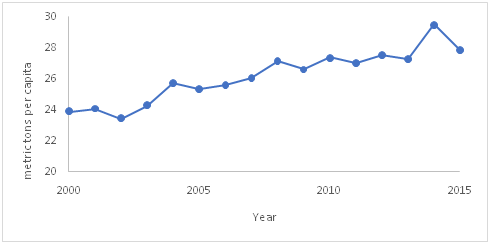
Figure 2 Trend of carbon emissions
Source of data: Data was extracted from the world bank (https://databank.worldbank.org/)
4.The future of AfCFTA carbon emissions if the current trend continues
By employing the Heteroscedasticity, and Autocorrelation Consistent (HAC) model, which addresses the common violation time series problem and utilizes less extensive datasets with moderate mathematical operations, a forecast of carbon emissions is made for some countries that have ratified the AfCFTA agreement. The forecasting results based on the business as usual (BAU) are highlighted as follows:
I. Countries that have ratified the trade agreement will increase their trade volumes, economic activities, and urbanization activities in these countries will increase. Trade activities coupled with urbanization and economic will contribute to carbon emissions.
II. 16% of emissions from Africa for the next decade will be due to the signing of the trade treaty. Thus, trade openness will drive Africa's emissions over the next ten years.
III. With the ratification of the AfCFTA agreement, African countries will increase their carbon emissions per capita by 17% in respect to their 2015 emissions if mitigation measures are not implemented.
5.Prospects for green Africa even with AfCFTA ratification
The global emission has reached a code red-point. The alarm bells from emissions are thunderous, and the evidence is overwhelming. African countries and the rest of the World is at imminent risk of hitting 1.50C, and the World should expect more flooding, wildfires, storms, and heatwaves. With the emissions from African countries expected to rise due to the ratification of AfCFTA, drastic measures are needed to salvage the environment from continuous destruction. A radical mitigation pathway that captures volatities of emissions determinants should be adopted by each African country. Among the strategies that should be adopted includes practices that countries should minimize and those activities that should be maximized.
Regarding activities that should be minimized include:
I. the importation of second-hand electrical commodities that exacerbate CO2 emissions should be discouraged. Special regulations should be made to restrict the importation of certain second-hand goods with high emissions
II. Urbanization should be discouraged in each country. Policymakers are encouraged to continuously see to the provision of basic infrastructure(schools, toilets, roads, light) and set up companies in less-density areas to discourage movement to urban places. Countries can learn from the Ghanaian one district one factory policy whereby every district is being targeted to get jobs on their own to discourage them from migrating.
On the other hand, countries are encouraged to maximize some activities that promote friendlier environmental practices. Among these practices includes
I. Policymakers should encourage the use of energy-efficient machines for economic activities.
II. Human capital should be maximized, and citizens need to be equipped with the technical know-how to use resources efficiently. Countries can consider devising policies to encourage firms to inculcate environmental preservation training in the induction activities for new staff.
III. Strong financial institutions in the form of policies directed at loans and guarantee support should be made available to firms to finance their green production activities.
IV. Renewable energy should be promoted, and countries can learn from Nigeria and take measures to phase out coal-fired power plants and other high emissions equipment and invest in Clean Technology. Adopting cleaner energy is one of the surest ways to encourage cleaner production.
The recommended mitigation strategy should be reassessed at least every five years based on the trends. When countries follow these strategies radically and observe green practices, AfCFTA countries will collectively emit zero carbon emissions per capita by 2028. Figure 3 shows the BAU and the emissions level after the mitigation strategies up to 2030. The red part shows what will happen to Africa's emissions if current trends continue. The green part shows the expected emission levels when mitigation strategies are adopted.
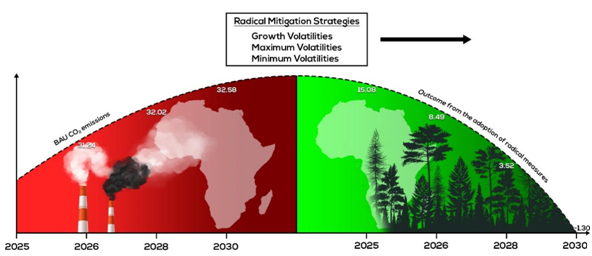
Figure 3 BAU forecasting and mitigation results
The author constructed this figure
6.Directions for AfCFTA Policy Makers on financing environmentally friendly projects
As most African countries are struggling due to the economic hardship of COVID-19, financing environmentally friendly related activities in Africa will require external assistance from developed countries to mitigate to an appreciable level. To address this financial challenge, AfCFTA countries can consider the options below.
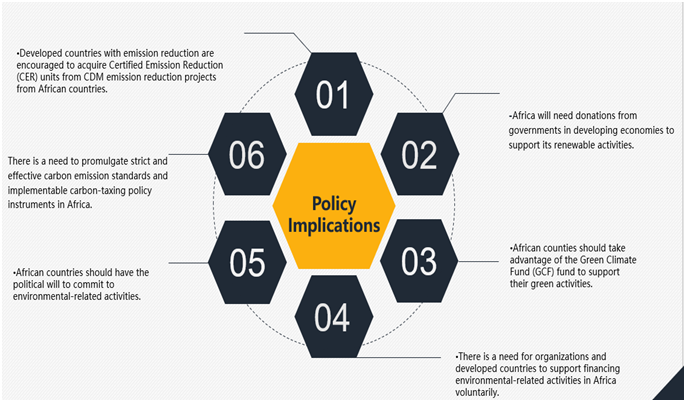
Figure 4 Policy directions
Source: The author own constructed this figure
7.Conclusion
Saving the global climate from its code-red status requires radical measures. Since human activities like trade highly influence the environmental outcome, AfCFTA countries should adopt radical measures to mitigate the negative effects of carbon emissions.
In addition, Policymakers within AfCFTA countries should cooperate with advanced countries with the technical know-how on environmental technologies to address these challenges. Partnering with firms with such know-how could encourage knowledge spillovers from clean technologies into AfCFTA. Some of the mitigation strategies these countries can adopt to reduce emissions include advocating for solar energy use, smart city initiatives, and improving fuel.
A balanced implementation of these strategies can decrease GHG and improve the quality of the environment.
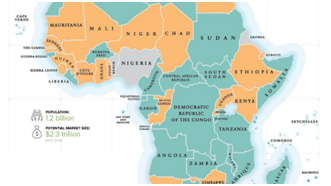
The full version of this project has been published in the Journal of Cleaner Production:
Opoku-mensah, E., Yin, Y., Oppong, A., Adjei, P., Sai, R., & Tuffour, P. (2021). African Continental Free Trade Area treaty and CO2: A volatility-driven CO2 mitigation pathways model for ratified countries. Journal of Cleaner Production, 328(2006), 129570. https://doi.org/10.1016/j.jclepro.2021.129570
This project was funded by the Center for West Africa Studies Doctoral Research Innovation Fund. Project number CXJJ2021072601